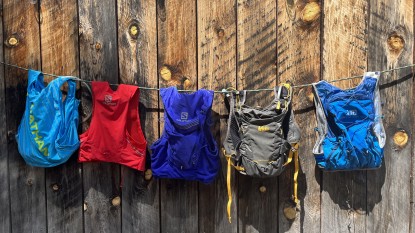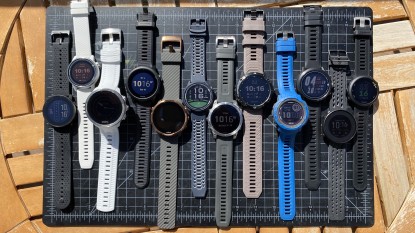Running, at its core, is simple when it comes to gear — a pair of shoes, shorts, and a t-shirt, easy! Well, maybe not quite so easy when there seems to be endless shirts out there to choose from, all claiming to be the best, the lightest, the most comfortable. With the hope of shedding some light on what to look for, our testers ran many miles in many shirts to help you figure out which ones are right for your running needs. If you already have a good idea of what qualities in a running shirt are important to you, check out our "Overview" where we highlight the award-winning products and how we chose them. If you're still not sure what to be looking for, this article will break down the subtle differences in fabrics, seams, breathability, and more so that you can determine which tee is best for you.
Comfort
Almost nothing is more important in running apparel than comfort. As the miles get longer, any little irritation will become exacerbated and can potentially cause rubbing and chafing. The best running shirt is one you don't have to think about at all 20 miles into your long Sunday run. We spent weeks wearing these shirts so that we could really get to know them, and we had our friends and colleagues try them too in order to reach a consensus. Below, we'll expand on what we think you should look for when it comes to comfort.
Fabric
Of the shirts we tested this season, most are polyester, or a blended polyester, while one is a merino wool blend. These fabrics can have vastly different qualities and feel, and while some of this decision will come down to how you expect your shirt to perform, a lot will also ride on personal preference.
PolyesterNowadays, when we think of activewear, we think of polyester. This synthetic material is known for being breathable, quick to dry, and reasonably comfortable, but it's also known for sometimes holding odors. Some polyester shirts use a treatment called Polygiene on their fabric, which prevents the growth of bacteria, and therefore minimizes odors. Other shirts blend polyester with a type of fabric called lyocell, mimicking the buttery softness of worn-in cotton without the drawback of cotton's slow drying time.
Merino
Although merino wool may not be the first type of fabric that comes to mind when you think of activewear, this fabric excels because of its ability to naturally regulate temperature and minimize odor. It can keep you warm even when it's wet, can keep you cool when the weather heats up, and you'll find you don't need to wash it as often as your polyester shirts, extending the life of the garment — which is good because it's usually more expensive too! If you are running in climates with variable weather or taking just one shirt in your pack on a running vacation, merino can be a great option. Our testers don't have any issues with skin sensitivities and merino, but if you've never worn it before, be sure to try it on in person to guarantee that you don't experience itchiness or have a wool allergy.
Seams
Seams, where the pieces of fabric are joined together, may not be very important in your day-to-day clothing, but in your running apparel, they can be surprisingly divisive. Running is so repetitive that tiny differences in stitching rubbed against the same spot on your skin thousands of times in the course of an hour can have very different results. If you are prone to chafing or wear a running vest or pack, seams are a characteristic to pay a bit more attention to.
Seam LocationOne of the biggest struggles we're looking to avoid with seams is chafing, and the most prominent way seams cause chafing is with their location. Our preference is for shirts whose seams don't lay directly along the top of the shoulders, which is especially appreciated if you're wearing a pack. Some shirts also have gussets underneath the arms that help with fit and decrease the likelihood of underarm chafing. Our best suggestion when it comes to seam location is to try shirts on when possible since how and where seams lay will be a little different on every body.
Seam Type
We encountered a few different types of seams in testing. Flatlock seaming is the most popular choice for higher-end athletic wear because of its low profile, which leads to less potential for rubbing. Similar in appearance from the outside of a shirt, overlock seaming, differs from flatlock by leaving a thin strip of fabric unsecured from the body of the garment on the inside of the shirt. This slight extra bulk and the ability for that strip of fabric to move can cause chafing if you have sensitive skin. Taped seams are becoming more popular as well. They are even pricier to produce than flatlock seams, but are the best for preventing chafing. Taped seams present with an almost seamless aesthetic, which changes the look of the garment. Taped seams are our top choice for what to wear beneath a hydration vest. The last seam we encountered is the plain seam. This is by far the cheapest to produce and was seen in a couple of the less expensive shirts in our review. This seam can have similar rubbing potential to the overlock seam but is also less durable.
Breathability & Drying Speed
After keeping us comfortable, the most important thing we want our athletic wear to accomplish is keeping us cool and dry. Though closely related, we feel it's important to rate shirts on both their breathability and their drying speed individually because of the slight differences in the way these traits are achieved.
Breathability is a shirt's ability to allow air to pass through so that sweat doesn't get trapped against the skin. This can be achieved in a variety of different ways, including looser fits, thinner fabrics, strategic mesh panels, or even tiny perforations in the fabric.
Drying Speed is the measure of how quickly a shirt can dry once it's saturated with moisture. In cold weather, you want your shirt to dry as quickly as possible so that the moisture doesn't make you cold. In hot weather, that evaporation process is actually what helps cool you down.
Features & Versatility
This aspect can be a bit more subjective than others since the features and the amount of versatility needed will vary for each runner. When you're buying a running shirt, especially if you're spending a significant bit of money on what seems like "just a t-shirt," you want to make sure that you're getting exactly what you need — whether that's a highly specialized shirt or a more versatile one. Read on as we expand on these different characteristics.
Sun Protection
Wearing a shirt while running will obviously offer more sun protection than not wearing one, but some shirts provide more shelter from the rays than others. Some of this can be achieved by the cut of the shirt — the length of the sleeves or the neckline. Some shirts will also list a UPF (Ultra-violet Protection Factor) rating, which indicates the level of protection comparable to the SPF rating of sunscreen. If this is a high priority for you, keep an eye out for shirts specifically marked with a UPF rating.
Reflectivity
If you frequently run at night, you may want to pay attention to whether or not a shirt has reflective decals. These are often incorporated into the logo and will shine bright white when a car's headlights or another runner's headlamp are pointed at them. Notice the number of reflective spots as well as the location. For example, if you run in the dark with a running vest on, will the decals be covered?
Versatility
Even though this is a running-focused review, we find versatility to be very important. Many of us, even the most diehard runners, also dabble in other sports. If that's you, a running shirt that is going to perform well when climbing, doing yoga, or backpacking might have more value to you than one that doesn't. A shirt like the Smartwool Merino 150 Baselayer scores high in this category because due to its fabric and fit, it can perform well across many activities, even acting as a base layer for snow sports or as the one perfect travel tee when you're heading off for your adventure running vacation with just a carry on!
Decision Making
When it comes down to it, take a real look at your current running and your upcoming running goals in order to determine what you need in your shirt.
One of the biggest factors to consider is what type of weather you will most often be running in. Maybe you're looking to purchase a top of the line performer in heat and want to be wearing a t-shirt so that you have some sun protection, or maybe you're looking for one all-around tee that will carry you through the changing season. Do you get rained on frequently? Do you need something that will layer well under a jacket in cooler temps?
Another factor to look at is how far you like to run. The needs of a runner racing and training for shorter distances will be different than one spending full days out on trails. If you're a shorter distance runner, the type of seams a shirt has may not be as big of an issue since something that is uncomfortable after twelve hours can easily still be comfortable after just one.
Lastly, your running environment can affect your purchase choice, too. Whether you're on the roads, the treadmill, or trails, your style and function needs may differ. Keep all these factors and questions in mind as you read through our women's running shirt review.
Conclusion
We hope this article helps provide you with more context for what we look for and why our reviews can be so lengthy and in-depth. As runners and gear reviewers, we just have so many opinions. Happy shopping, and most importantly, happy running!






















